ESP MERCEDES-BENZ C-Class COUPE 2017 CL205 User Guide
[x] Cancel search | Manufacturer: MERCEDES-BENZ, Model Year: 2017, Model line: C-Class COUPE, Model: MERCEDES-BENZ C-Class COUPE 2017 CL205Pages: 354, PDF Size: 8.66 MB
Page 40 of 354
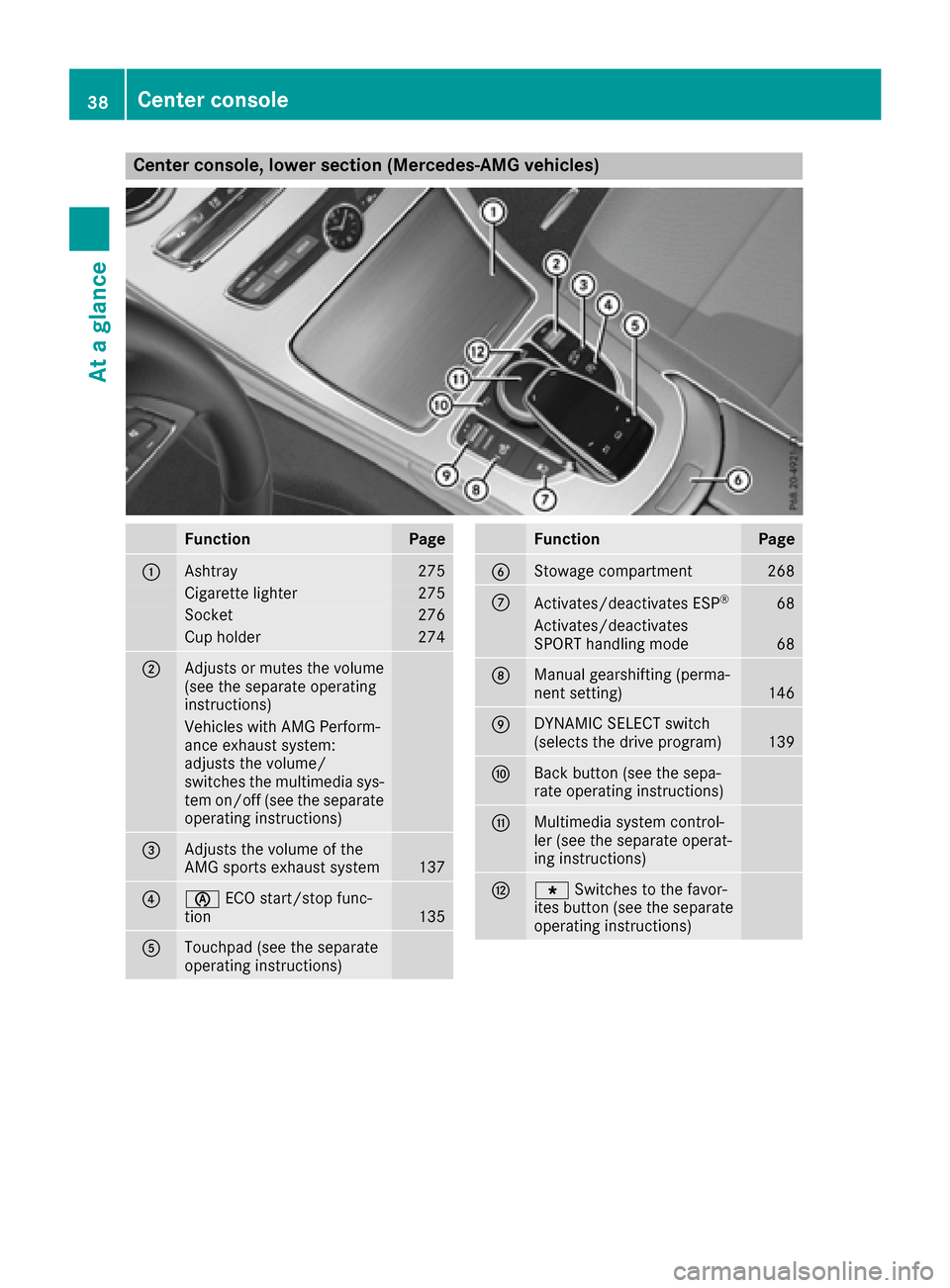
Center console, lower section (Mercedes-AMGvehicles)
FunctionPage
:Ashtray275
Cigarett elighter275
Socket276
Cup holder274
;Adjustsorm utes thevolume
(see th eseparate operating
instructions)
Vehicle swithA MGPerform-
anc eexhaust system:
adjustst hevolume/
switches th emultimedia sys-
te mo n/off(see th eseparate
operatin ginstructions)
=Adjustst hevolum eofthe
AM Gsports exhaust system137
?è ECO start/sto pfunc-
tion135
ATouchpad (see th eseparate
operatin ginstructions)
FunctionPage
BStowage compartment268
CActivates/deactivate sESP®68
Activates/deactivates
SPORT handlingm ode68
DManual gearshiftin g(perma-
nent setting)146
EDYNAMIC SELECT switch
(select sthe driv eprogram)139
FBac kbutto n(see th esepa-
rat eo peratin ginstructions)
GMultimedia system control-
ler (see th eseparate operat-
ing instructions)
Hg Switches to th efavor-
ite sb utto n(see th eseparate
operatin ginstructions)
38Center console
At ag lance
Page 47 of 354
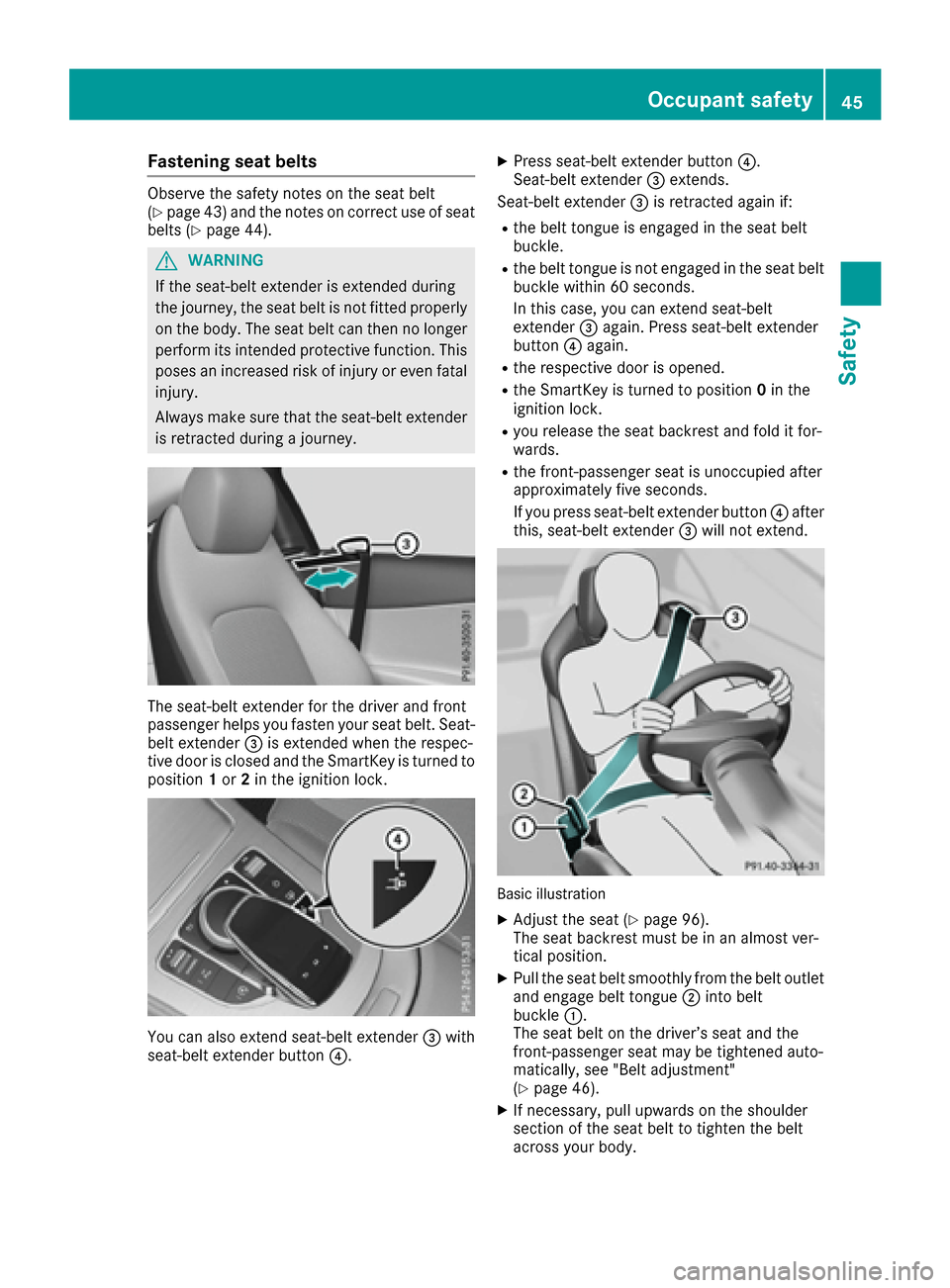
Fastening seat belts
Observethe safet ynotes on th eseat belt
(Ypage 43 )and the notes on correct us eofseat
belts (Ypage 44).
GWARNING
If the seat-belt extender is extended during
the journey ,the sea tbeltisn ot fitte dproperly
on the body .The sea tbeltc an then no longer
perfor mits intende dprotective function. This
poses an increased ris kofinjury or eve nfatal
injury.
Alway smakes uret hatt he seat-belt extender
is retracted during ajourney.
The seat-belt extender for the driver and front
passenger helps yo ufasten your sea tbelt. Seat-
belt extender =is extended when the respec-
tive door is closed and the SmartKey is turne dto
position 1or 2in the ignition lock.
Yo uc an also extend seat-belt extender =with
seat-belt extender button ?.
XPress seat-belt extender button ?.
Seat-belt extender =extends.
Seat-belt extender =is retracted agai nif:
Rthe belt tongu eisengaged in the sea tbelt
buckle.
Rthe belt tongu eisnot engaged in the sea tbelt
buckle within6 0seconds.
In thisc ase, youcan extend seat-belt
extender =again. Press seat-belt extender
button ?again.
Rthe respective door is opened.
Rthe SmartKey is turne dtoposition 0in the
ignition lock.
Ryo ur elease the sea tbackres tand fol ditfor-
wards.
Rthe front-passenger sea tisu noccupie dafter
approximatelyf ives econds.
If yo upress seat-belt extender button ?after
this, seat-belt extender =will not extend.
Basic illustration
XAdjust the sea t(Ypage 96).
The sea tbackres tmustbeinana lmostv er-
tica lposition.
XPull the sea tbelts moothl yfrom the belt outlet
and engage belt tongue ;into belt
buckle :.
The sea tbeltont he driver’ sseata nd the
front-passenger sea tmaybe tightene dauto-
matically, see "Belt adjustment"
(
Ypage 46).
XIf necessary,p ullu pwar ds on the shoulder
section of the sea tbelttot ighten the belt
across your body.
Occupant safety45
Safety
Z
Page 50 of 354
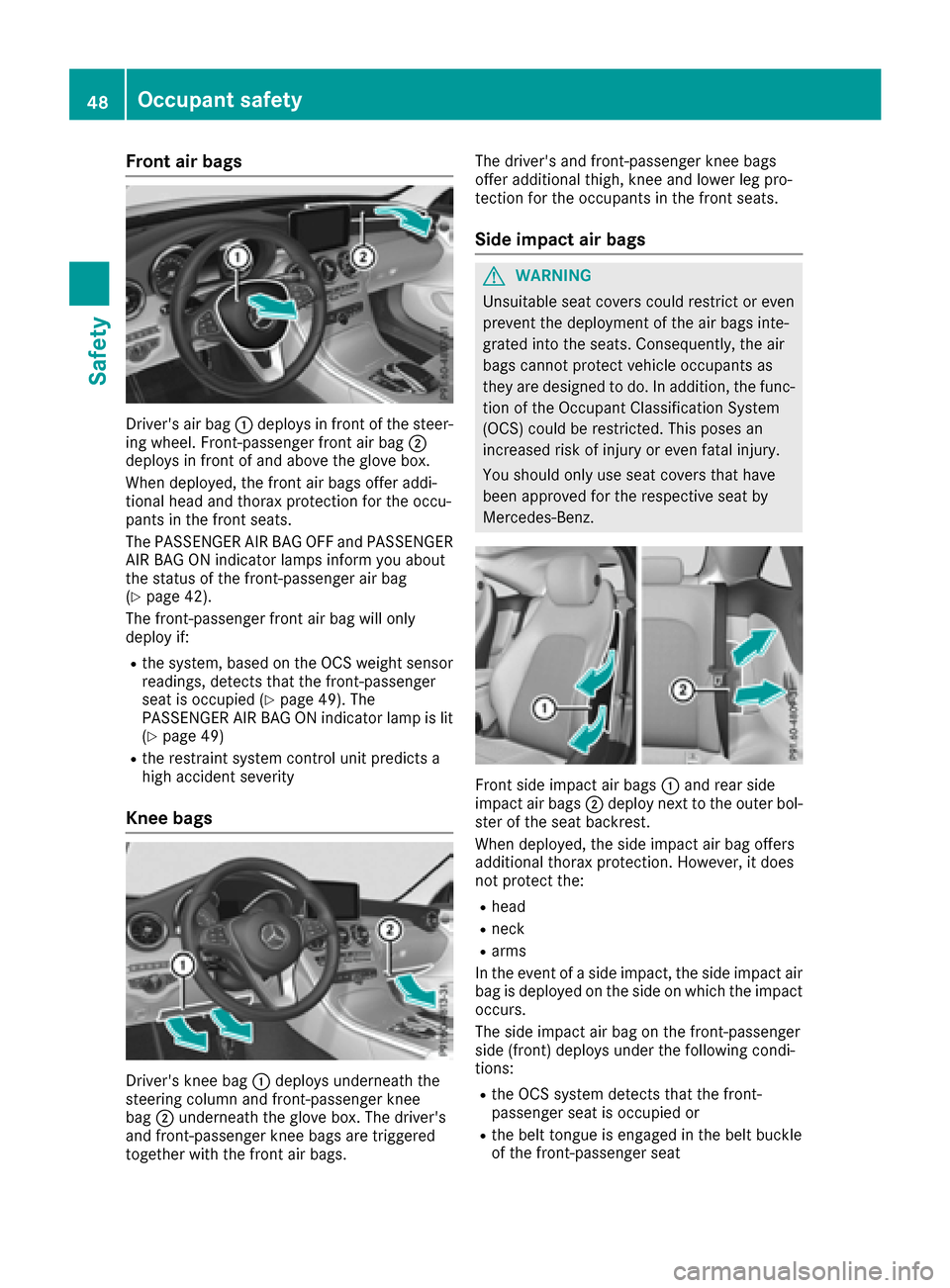
Frontair bags
Driver's air bag :deploys in fron tofthesteer -
ing wheel. Front-passenger fron tair bag ;
deploys in fron tofand abov ethe glov ebox.
When deployed, th efront air bags offer addi-
tional head and thorax protection for th eoccu-
pants in th efront seats.
The PASSENGER AI RBAG OFFa nd PASSENGER
AI RB AG ON indicator lamp sinform you about
th es tatus of th efront-pa ssenger air bag
(
Ypage 42).
The front-passenger fron tair bag will only
deplo yif:
Rthes ystem, based on th eOCS weigh tsensor
readings, detect sthatthe front-passenger
seat is occupied (
Ypage 49).The
PASSENGER AI RBAG ON indicator lamp is lit
(
Ypage 49)
Rth er estrain tsystem control unit predicts a
high acciden tseverit y
Knee bags
Driver's knee bag :deploys underneat hthe
steering column and front-passenger knee
bag ;underneat hthe glov ebox.T he driver' s
and front-passenger knee bags are triggered
together wit hthe fron tair bags . The driver'
sand front-passenger knee bags
offer additional thigh, knee and lower leg pro -
tection for th eoccupant sinthefron tseats.
Sidei mpact air bags
GWARNIN G
Unsuitable seat cover scould restrict or eve n
preven tthe deploymen toftheair bags inte-
grated int othe seats. Consequently, th eair
bags canno tprotect vehicl eoccupant sas
they are designed to do. In addition ,the func-
tion of th eOccupant Classification Syste m
(OCS )cou ld be restricted. This poses an
increased ris kofinjury or eve nfatal injury.
You should only use seat cover sthath ave
been approve dfor th erespective seat by
Mercedes-Benz.
Fron tside impac tair bags :and rear side
impact air bags ;deplo ynexttot heouter bol-
ster of th eseat backrest .
When deployed, th eside impac tair bag offers
additional thorax protection .How ever, it does
no tp rotect the:
Rhead
Rneck
Rarm s
In th eevent of aside impact, th eside impac tair
bag is deployed on th eside on whic hthe impac t
occurs.
The side impac tair bag on th efront-pa ssenger
side (front) deploys under th efollowin gcondi -
tions:
Rth eO CS system detect sthatthe front-
passenger seat is occupied or
Rth eb elt tongue is engage dinthebelt buckle
of th efront-pa ssenger seat
48Occupant safety
Safety
Page 52 of 354
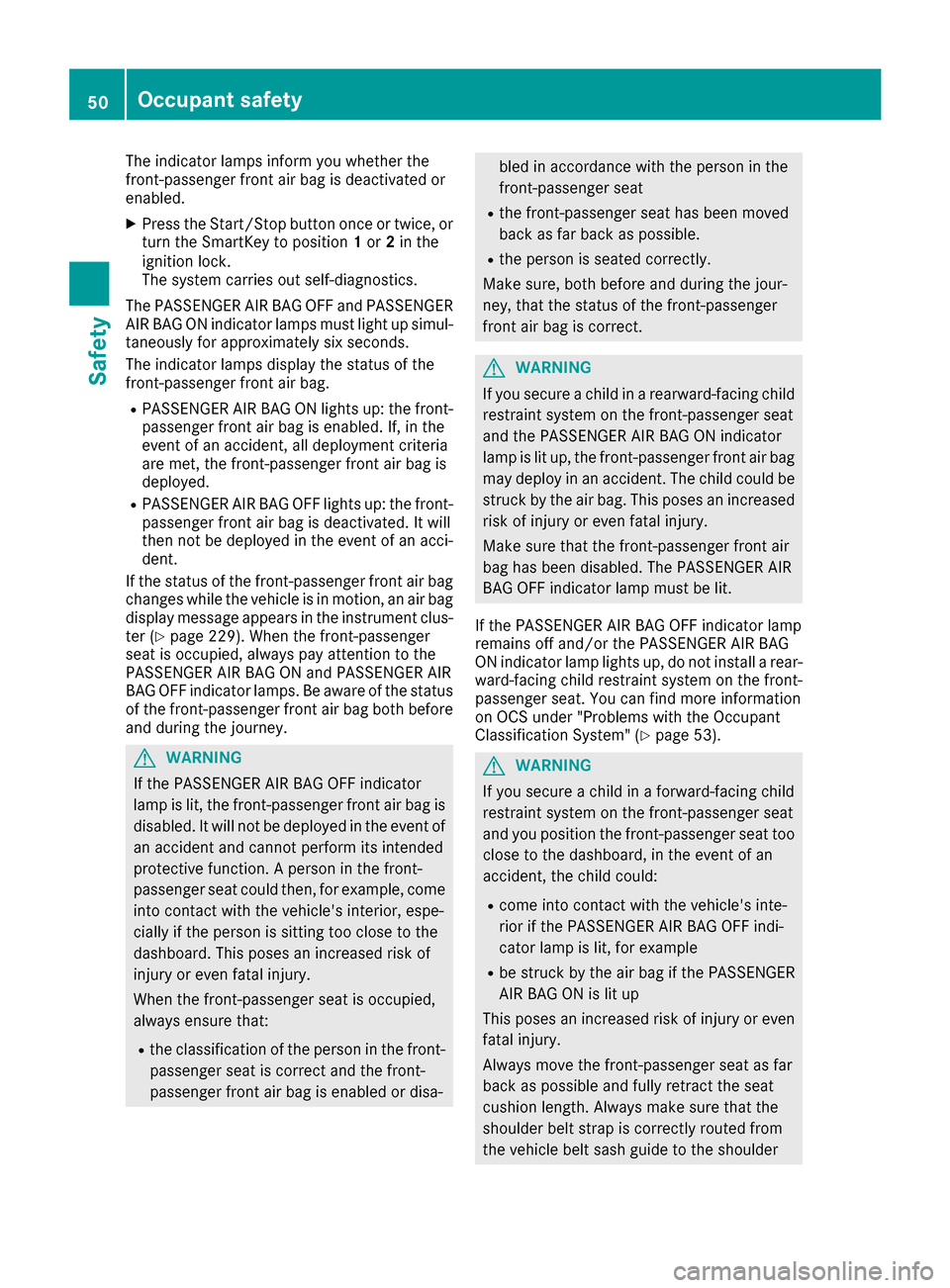
The indicator lamps inform you whether the
front-passenger front air bag is deactivated or
enabled.
XPress the Start/Stop button once or twice, or
turn the SmartKey to position1or 2in the
ignition lock.
The system carries out self-diagnostics.
The PASSENGER AIR BAG OFF and PASSENGER
AIR BAG ON indicator lamps must light up simul-
taneously for approximately six seconds.
The indicator lamps display the status of the
front-passenger front air bag.
RPASSENGER AIR BAG ON lights up: the front-
passenger front air bag is enabled. If, in the
event of an accident ,all deployment criteria
are met, the front-passenger front air bag is
deployed.
RPASSENGER AIR BAG OFF lights up: the front-
passenger front air bag is deactivated. It will
then not be deployed in the event of an acci-
dent.
If the status of the front-passenger front air bag changes while the vehicle is in motion,ana ir bag
display message appears in the instrument clus-
ter (
Ypage 229). When the front-passenger
seat is occupied, alwaysp ay attention to the
PASSENGER AIR BAG ON and PASSENGER AIR
BAG OFF indicator lamps. Be aware of the status
of the front-passenger front air bag both before
and during the journey.
GWARNING
If the PASSENGER AIR BAG OFF indicator
lamp is lit, the front-passenger front air bag is
disabled. It will not be deployed in the event of
an accident and cannot perform its intended
protective function. Aperson in the front-
passenger seat could then ,for example, come
into contact with the vehicle's interior, espe-
cially if the person is sittin gtoo close to the
dashboard. This poses an increased risk of
injury or even fatal injury.
When the front-passenger seat is occupied,
alwayse nsure that:
Rthe classification of the person in the front-
passenger seat is correcta nd the front-
passenger front air bag is enabled or disa-
bled in accordanc ewith the person in the
front-passenger seat
Rthe front-passenger seat has been moved
back as far back as possible.
Rthe person is seated correctly.
Make sure, both before and during the jour-
ney, that the status of the front-passenger
front air bag is correct.
GWARNING
If you secure achild in arearward-facing child
restraint system on the front-passenger seat
and the PASSENGER AIR BAG ON indicator
lamp is lit up, the front-passenger front air bag may deploy in an accident .The child could be
struck by the air bag. This poses an increased
risk of injury or even fatal injury.
Make sure that the front-passenger front air
bag has been disabled. The PASSENGER AIR
BAG OFF indicator lamp must be lit.
If the PASSENGER AIR BAG OFF indicator lamp
remains off and/or the PASSENGER AIR BAG
ON indicator lamp lights up, do not install arear-
ward-facing child restraint system on the front-
passenger seat. You can find more information
on OCS under "Problems with the Occupant
Classification System" (
Ypage 53).
GWARNING
If you secure achild in aforward-facing child
restraint system on the front-passenger seat
and you position the front-passenger seat too close to the dashboard, in the event of an
accident ,the child could:
Rcome into contact with the vehicle's inte-
rior if the PASSENGER AIR BAG OFF indi-
cator lamp is lit, for example
Rbe struck by the air bag if the PASSENGER
AIR BAG ON is lit up
This poses an increased risk of injury or even fatal injury.
Always move the front-passenger seat as far
back as possible and fully retrac tthe seat
cushion length. Always make sure that the
shoulder belt strap is correctly routed from
the vehicle belt sash guide to the shoulder
50Occupant safety
Safety
Page 54 of 354
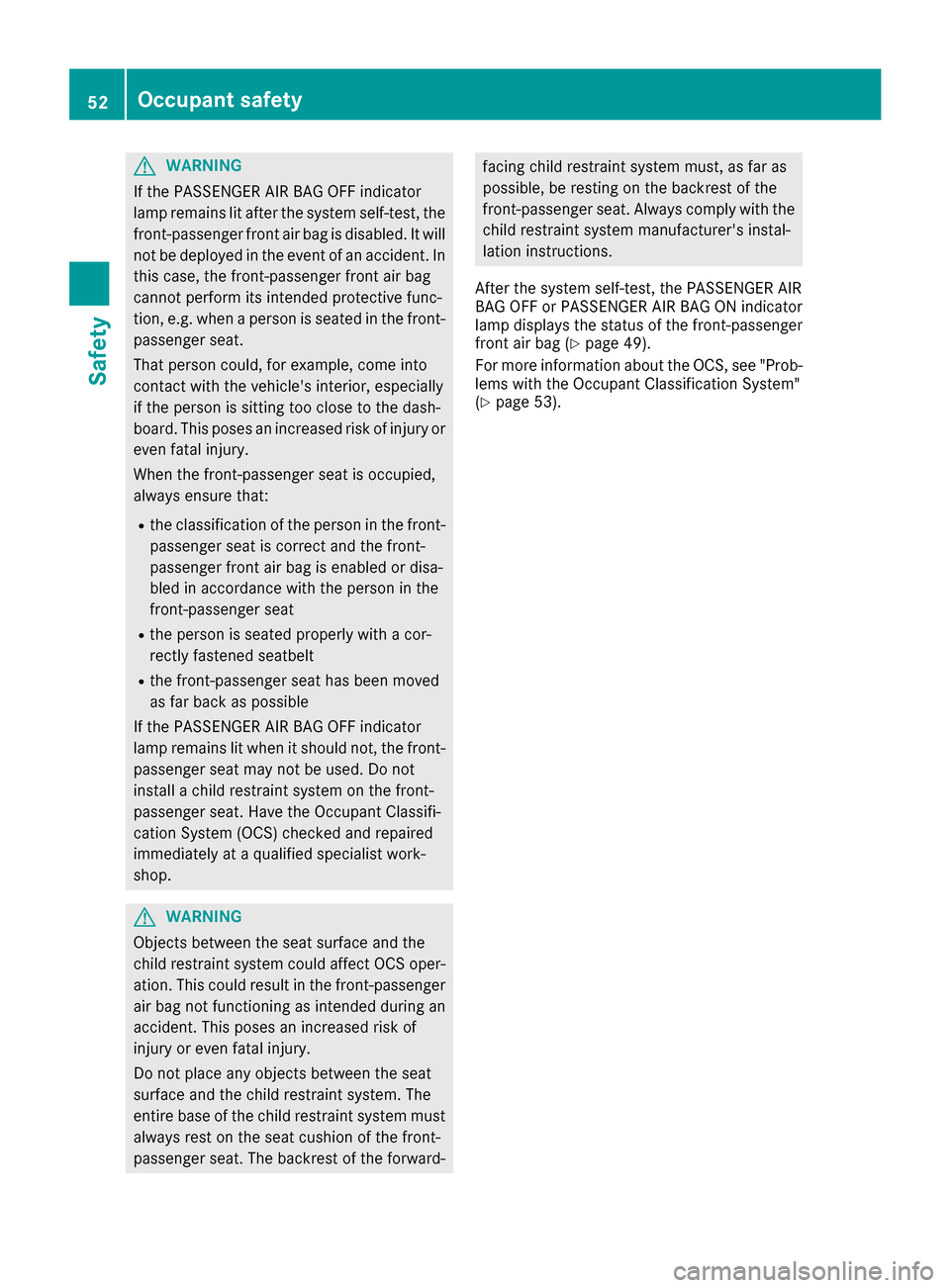
GWARNING
If the PASSENGER AIR BAG OFF indicator
lamp remains lit after the system self-test, the
front-passenge rfront air bag is disabled. It will
not be deploye dinthe event of an accident. In
this case, the front-passenge rfront air bag
cannot perform its intended protective func-
tion, e.g. when apersoniss eated in the front-
passenger seat.
That personc ould, for example, come into
contact with the vehicle's interior, especially
if the personiss itting too close to the dash-
board. This poses an increased risk of injury or
even fatal injury.
When the front-passenge rseat is occupied,
alway sensure that:
Rthe classification of the personint he front-
passenger seat is correct and the front-
passenger front air bag is enabled or disa-
bledina ccordance with the personint he
front-passenge rseat
Rthe personiss eated properly with acor-
rectly fastened seatbelt
Rthe front-passenge rseat has been moved
as far back as possible
If the PASSENGER AIR BAG OFF indicator
lamp remains lit when it should not, the front-
passenger seat may not be used .Donot
instal lachild restraint system on the front-
passenger seat. Have the Occupant Classifi-
cation System (OCS) checked and repaired
immediatel yataqualified specialist work-
shop.
GWARNING
Objects between the seat surface and the
child restraint system coul daffect OCS oper-
ation. This coul dresult in the front-passenger
air bag not functioning as intended during an
accident. This posesani ncreased risk of
injury or even fatal injury.
Do not place any objects between the seat
surface and the child restraint system. The
entire base of the child restraint system must
alway srest on the seat cushion of the front-
passenger seat. The backrest of the forward-
facing child restraint system must, as far as
possible,ber esting on the backrest of the
front-passenge rseat. Always comply with the
child restraint system manufacturer's instal-
lation instructions.
After the system self-test, the PASSENGER AIR
BAG OFF or PASSENGER AIR BAG ON indicator
lamp display sthe status of the front-passenger
front air bag (
Ypag e49).
For more information about the OCS, see "Prob-
lems with the Occupant Classification System"
(
Ypag e53).
52Occupant safety
Safety
Page 56 of 354
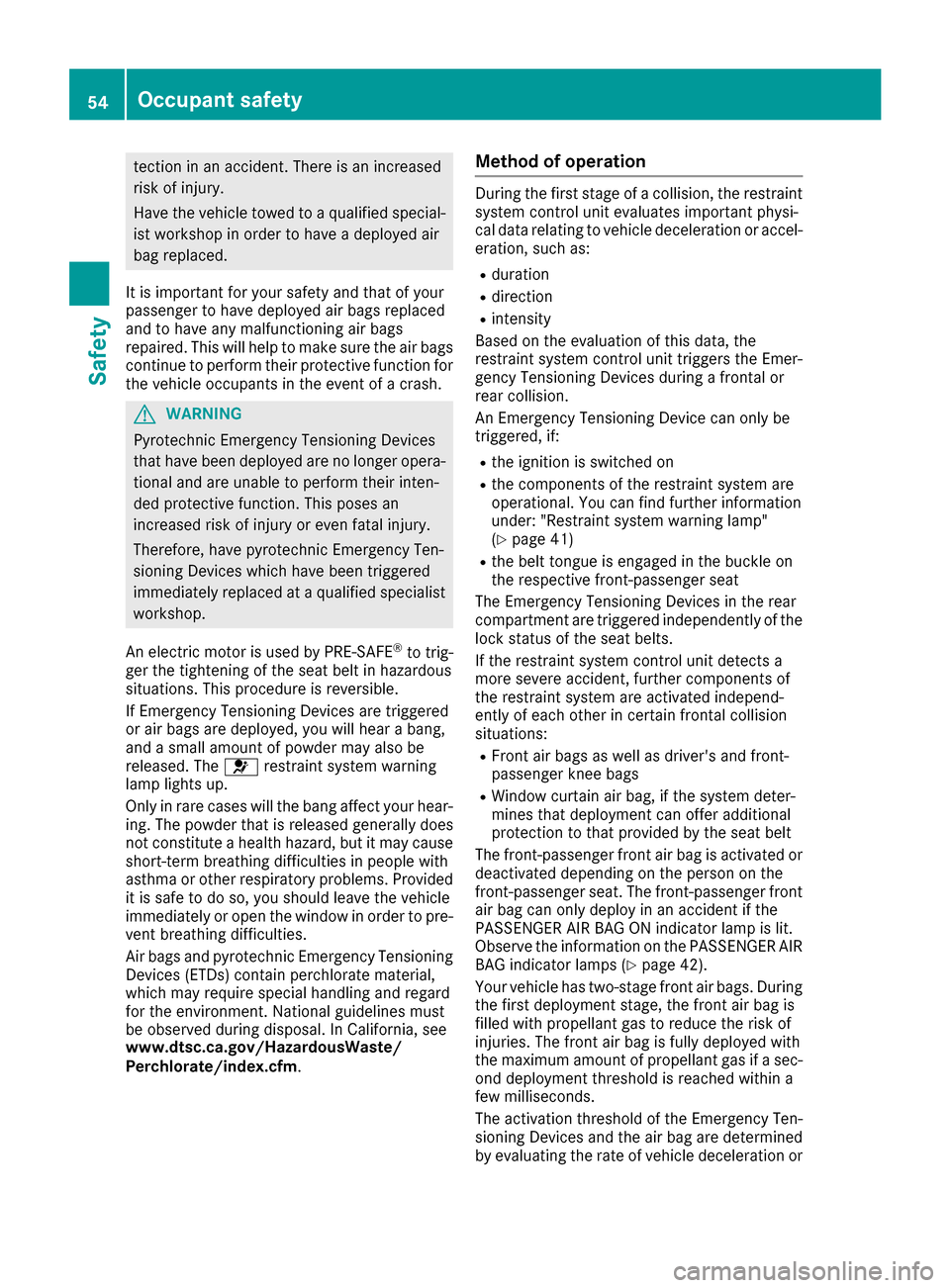
tection in an accident. There is an increased
riskofi njury.
Hav ethe vehicl etowed to aquali fied special-
is tw orkshop in order to have adeployed air
ba gr eplaced.
It is important for your safety and thatofy our
passenge rtohaved eployed airb agsr eplaced
and to have any malfunctioning ai rbags
repaired .Thisw illh elptom akes uret he ai rbags
continue to perform their protective functio nfor
the vehicl eoccupants in the event of acrash.
GWARNING
Pyrotechni cEmergency Tensioning Devices
thath aveb eend eployed arenol ongero pera-
tional and ar eunabl etop erform their inten-
de dp rotective function. Thi sposes an
increasedr iskofi njury or eve nfatal injury.
Therefore ,havep yrotechni cEmergency Ten-
sioning Devices which have been triggered
immediatel yreplaced at aquali fied specialist
workshop.
An electri cmotorisu sedbyP RE-SAFE
®to trig-
ge rthe tightening of the seat belt in hazardous
situations. Thi sprocedur eisreversible.
If Emergency Tensioning Devices ar etriggered
or ai rbagsa redeployed ,you will hear abang,
and asmall amount of powder maya lsob e
released. The 6restraint systemw arning
lamp lights up.
Onlyinr arec ases will the bang affect your hear-
ing .The powder thati sreleasedg enerall ydoes
not constitute ahealth hazard, bu titmaycause
short-ter mbreathing difficultie sinpeoplewith
asthma or othe rrespiratory problems .Provided
it is safe to do so, yo ushoul dleave the vehicle
immediatel yoropent he windo winorder to pre-
vent breathing difficulties.
Air bags and pyrotechni cEmergency Tensioning
Devi ces (
ETDs) contain perchlorate material,
which mayr equire special handling and regard
for the environment. National guideline smust
be observe dduringd ispo sal. In California ,see
www.dtsc.ca.gov/HazardousWaste/
Perchlorate/index.cfm.
Methodofo peration
During the first stage of acollision, the restraint
systemc ontrolunite valuate simportant physi-
cal data relating to vehicl edeceleratio noraccel-
eration, such as:
Rduration
Rdirection
Rintensity
Based on the evaluation of thisd ata, the
restraint systemc ontrol unittriggers the Emer-
gency Tensioning Devices durin gafrontal or
rea rcollision.
An Emergency Tensioning Device can onl ybe
triggered ,if:
Rthe ignition is switched on
Rthe components of the restraint systema re
operational .You can fin dfurthe rinformation
under: "Restraint systemw arning lamp"
(
Ypage 41)
Rthe belt tongue is engaged in the buckle on
the respectiv efront-passenge rseat
The Emergency Tensioning Devices in the rear
compartment ar etriggered independentl yofthe
lock status of the seat belts.
If the restraint systemc ontrol unitdetects a
mor eseverea ccident, furthe rcomponents of
the restraint systema reactivated independ-
entl yofe acho the rinc ertainfrontal collision
situations:
RFron tairbags as well as driver's and front-
passenge rknee bags
RWindo wcurtai nairbag, if the systemd eter-
mines thatd eployment can offer additional
protection to thatp rovided bythe s
eat belt
The front-passenge rfront ai rbag is activated or
deactivated depending on the perso nonthe
front-passenge rseat. The front-passenge rfront
ai rb ag can onl ydeplo yinana ccident if the
PASSENGER AIR BAG ON indicator lamp is lit.
Observe the information on the PASSENGER AIR
BAG indicator lamps (
Ypage 42).
Your vehicl ehastwo-stage front ai rbags. During
the first deployment stage ,the front ai rbag is
fille dwithp ropellant ga storeduce the ris kof
injuries. Th efront ai rbag is full ydeployed with
the maximum amount of propellant ga sifasec-
ond deployment threshold is reache dwithina
few milliseconds.
The activatio nthreshold of the Emergency Ten-
sioning Devices and the ai rbag ared etermined
by evaluating the rate of vehicl edeceleratio nor
54Occupant safety
Safety
Page 57 of 354
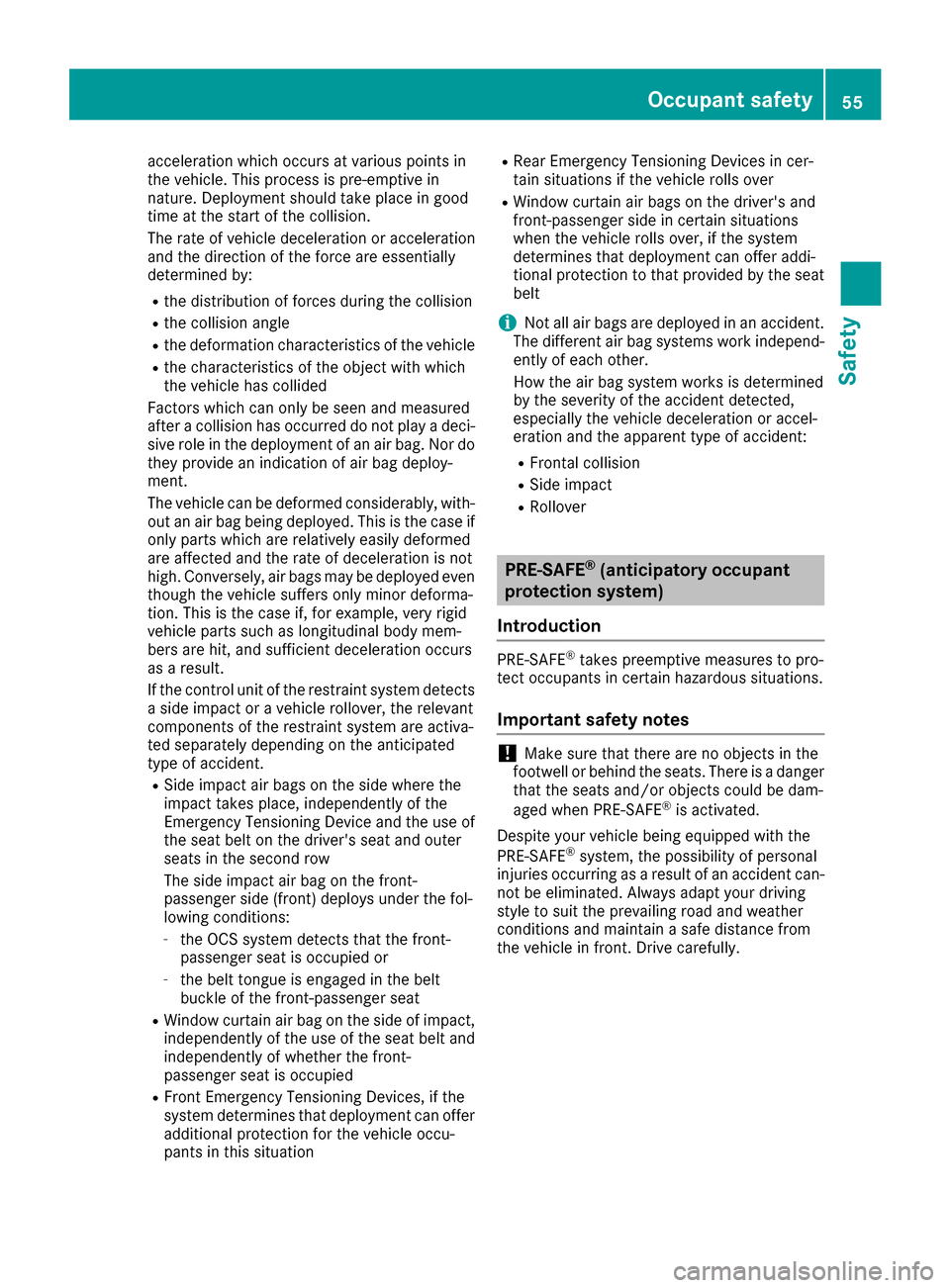
accelerationwhicho ccurs at various points in
th ev ehicle .This process is pre-emptive in
nature. Deployment shouldt akep lace in good
tim eatt hestart of th ecollision.
The rat eofvehicle deceleratio noracceleration
and th edirection of th eforce are essentially
determine dby:
Rthed istribution of forces durin gthe collision
Rthec ollision angle
Rthed eformatio ncharacteristics of th evehicle
Rthec haracteristics of th eobject with which
th ev ehicle has collided
Factors whichc an only be seen and measured
after acollision has occurre ddonotplay adeci-
sive role in th edeploymen tofanair bag. Nor do
they provide an indication of air bag deploy-
ment.
The vehicle can be deformed considerably, with-
out an air bag beingd eployed. This is thecaseif
only part swhicha re relatively easily deformed
are affected and th erateofd eceleratio nisnot
high.C onversely, air bags may be deployed even
though th evehicle suffers only minor deforma-
tion. This is th ecasei f, for example, ver yrigid
vehicle part ssuchasl ongitudinal body mem-
bers are hit,a nd sufficient deceleratio noccurs
as aresult.
If th econtrol unit of th erestraint system detects
as ide impac toravehicle rollover, th erelevant
component softherestraint system are activa-
te ds eparately dependingont heanticipated
type of acc ident
.
RSid
eimpacta ir bags on th eside wheret he
impac ttakes place ,independently of the
Emergenc yTensioning Devic eand th euse of
th es eat belt on th edriver'ss eat and outer
seatsint hesecondr ow
The side impac tair bag on th efront -
passenger side (front) deploys unde rthe fol-
lowingc onditions:
-theO CS system detect sthatthe front-
passenger seat is occupied or
-th eb elt tongue is engaged in th ebelt
buckle of th efront-pa ssenger seat
RWindow curtain air bag on th eside of impact,
independently of th euse of th eseat belt and
independently of whether th efront -
passenger seat is occupied
RFrontE mergenc yTensioning Devices, if the
system determine stha td eploymen tcan offer
additional protection for th evehicle occu-
pant sint hiss ituation
RRear Emergenc yTensioning Devices in cer-
tain situations if th evehicle roll sover
RWindow curtain air bags on th edriver'sa nd
front-passenger side in certain situations
when th evehicle roll sover, if th esystem
determine sthatd eploymen tcan offer addi-
tional protection to that provided by th eseat
belt
iNot all air bags are deployed in an accident.
The differenta ir bag systems work independ-
ently of each other.
How th eair bag system worksisd etermined
by th eseverityoft heaccidentd etected,
espec
ially th evehicle deceleratio noraccel-
eration and th eapparent type of accident:
RFrontal collision
RSid eimpact
RRollover
PRE-SAFE®(anticipator yoccupant
protection system)
Introduction
PRE-SAFE®takes preemptive measures to pro-
tect occupant sincertain hazardous situations.
Important safety notes
!Makes ure that there are no object sinthe
footwell or behindt heseats. Thereisad anger
that th eseatsa nd/or object scoul dbed am-
aged when PRE-SAFE
®is activated.
Despitey our vehicle beinge quippedwith the
PRE-SAFE
®system, th epossibilityofp ersonal
injuries occurring as aresult of an accidentc an-
no tbee liminated. Always adapt your driving
style to suit th eprevailingr oad and weather
conditionsa nd maintain asafe distanc efrom
th ev ehicle in front. Drive carefully.
Occupant safety55
Safety
Z
Page 61 of 354
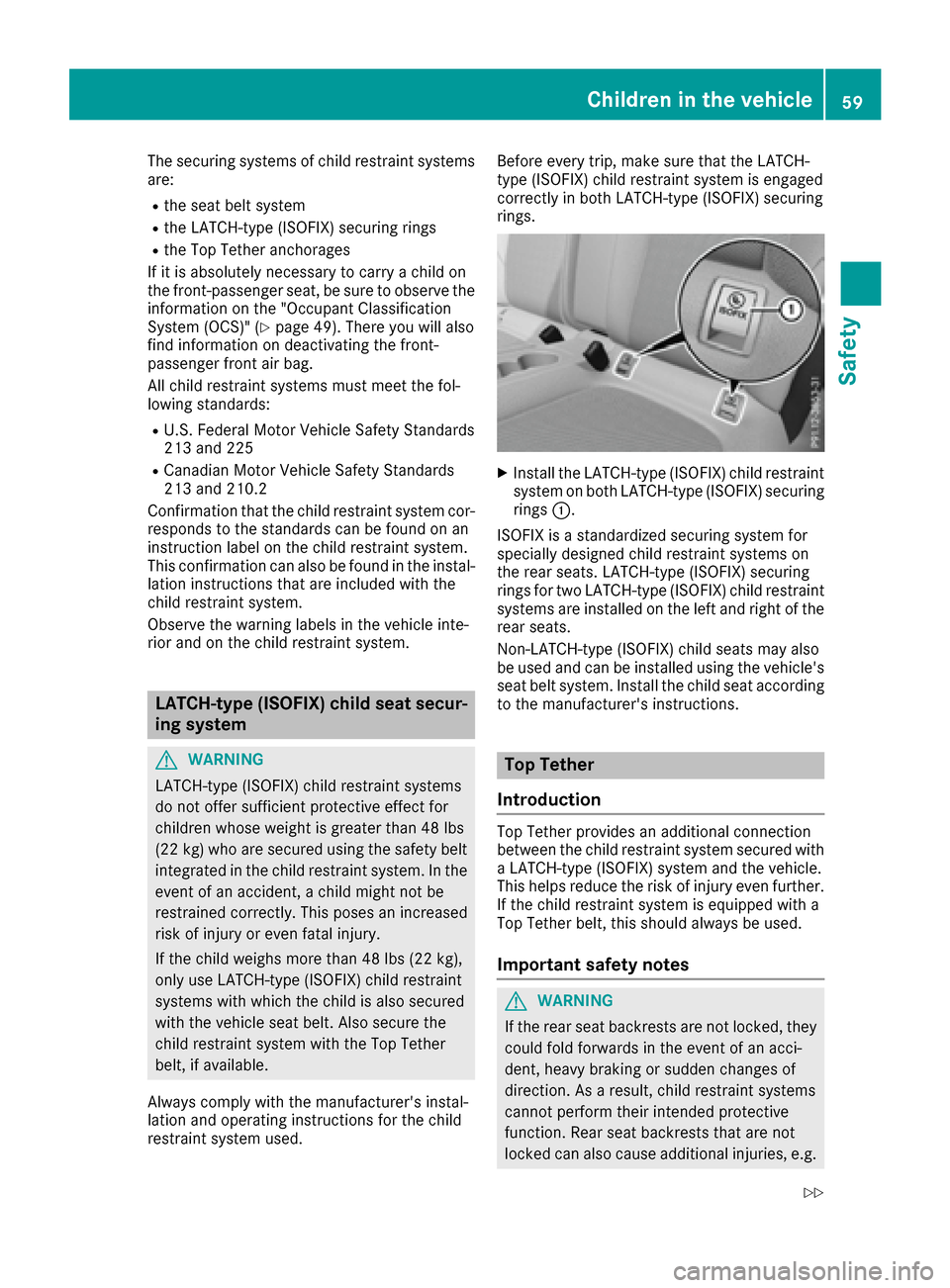
The securing systems of child restraint systems
are:
Rthe seat belt system
Rthe LATCH-type (ISOFIX) securing rings
Rthe Top Tether anchorages
If it is absolutely necessary to carry achild on
the front-passenger seat, be sure to observe the
information on the "Occupant Classification
System (OCS)" (
Ypage 49). There you will also
find information on deactivatin gthe front-
passenger front air bag.
All child restraint systems must meet the fol-
lowing standards:
RU.S. Federal Motor Vehicle Safety Standards
213 and 225
RCanadian Motor Vehicle Safety Standards
213 and 210.2
Confirmation that the child restraint system cor-
responds to the standards can be found on an
instruction label on the child restraint system.
This confirmation can also be found in the instal-
lation instructions that are included with the
child restraint system.
Observe the warning labels in the vehicle inte-
rior and on the child restraint system.
LATCH-type( ISOFIX) child seat secur-
ing system
GWARNING
LATCH-type (ISOFIX) child restraint systems
do not offer sufficient protective effect for
children whose weight is greater than 48 lbs
(22 kg )who are secured using the safety belt
integrated in the child restraint system. In the
event of an accident ,achild might not be
restrained correctly. This poses an increased
risk of injury or even fatal injury.
If the child weighs more than 48 lbs (22 kg),
only use LATCH-type (ISOFIX) child restraint
systems with which the child is also secured
with the vehicle seat belt. Also secure the
child restraint system with the Top Tether
belt, if available.
Always comply with the manufacturer's instal-
lation and operating instructions for the child
restraint system used. Before every trip, make sure that the LATCH-
type (ISOFIX) child restraint system is engaged
correctly in both LATCH-type (ISOFIX) securing
rings.
XInstall the LATCH-type (ISOFIX) child restraint
system on both LATCH-type (ISOFIX) securing
rings :.
ISOFIX is astandardized securing system for
specially designed child restraint systems on
the rear seats. LATCH-type (ISOFIX) securing
rings for two LATCH-type (ISOFIX) child restraint
systems are installed on the left and right of the
rear seats.
Non-LATCH-type (ISOFIX) child seats may also
be used and can be installed using the vehicle's
seat belt system. Install the child seat according
to the manufacturer's instructions.
Top Tether
Introduction
Top Tether provides an additional connection
between the child restraint system secured with
aL ATCH-type (ISOFIX) system and the vehicle.
This helps reduce the risk of injury even further.
If the child restraint system is equipped with a
Top Tether belt, this should alwaysbeu sed.
Important safety notes
GWARNING
If the rear seat backrest sare not locked, they
could fold forwards in the event of an acci-
dent, heavy braking or sudden changes of
direction .Asaresult, child restraint systems
cannot perform their intended protective
function. Rear seat backrest sthat are not
locked can also cause additional injuries, e.g.
Children in the vehicle59
Safety
Z
Page 63 of 354
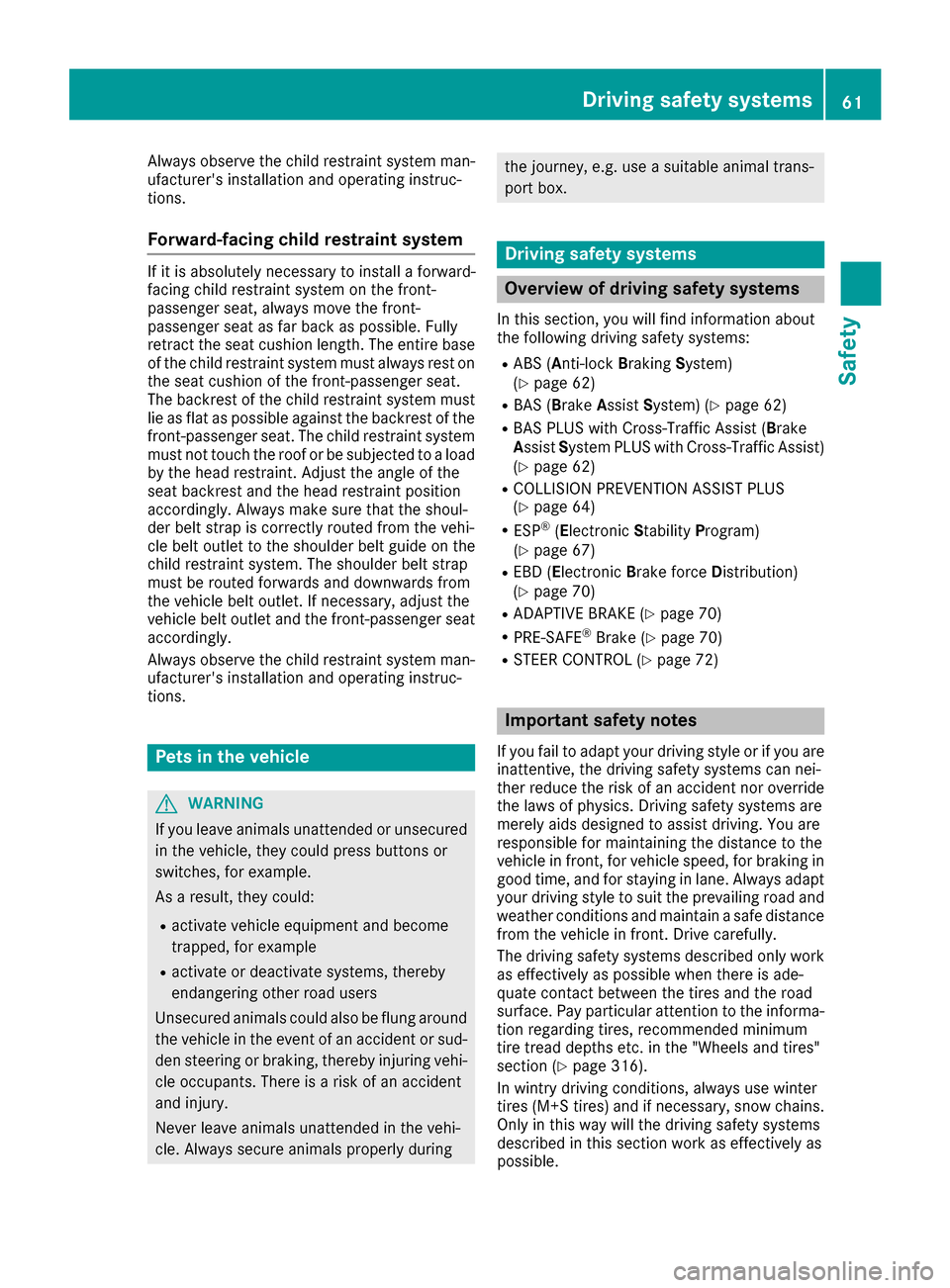
Alwaysobserve the child restraint system man-
ufacturer's installatio nand operating instruc-
tions.
Forward-facin gchild restrain tsystem
If it is absolutely necessary to instal laforward-
facing child restraint system on the front-
passengers eat, always move the front-
passengers eata sfar back as possible. Fully
retract the sea tcushion length. The entire base
of the child restraint system must always res ton
the sea tcushion of the front-passenger seat.
The backres tofthe child restraint system must
li easf lata sp ossibl eagain st the backres tofthe
front-passenger seat. The child restraint system
must not touch the roo forbesubjected to aloa d
by the hea drestraint. Adjust the angle of the
sea tbackres tand the hea drestraint position
accordingly. Alway smakes uret hatt he shoul-
de rb elts trapisc orrectlyrouted from the vehi-
cle belt outle ttothe shoulde rbeltg uide on the
child restraint system .The shoulde rbelts trap
must be routed forwards and downwards from
the vehicl ebelto utlet. If necessary,a djus tthe
vehicl ebelto utle tand the front-passenger seat
accordingly.
Alway sobserve the child restraint system man-
ufacturer's installatio nand operating instruc-
tions.
Pets in the vehicle
GWARNING
If yo uleave animals unattended or unsecured
in the vehicle, they could press buttons or
switches, for example.
As aresult, they could:
Ractivate vehicl eequipment and become
trapped, for example
Ractivate or deactivate systems, thereby
endangering othe rroa du sers
Unsecured animals could also be flung around
the vehicl einthe event of an accident or sud-
de ns teering or braking ,thereb yinjuring vehi-
cle occupants. There is ariskofana ccident
and injury.
Never leav eanimals unattended in the vehi-
cle .Alway ssecur eanimals properly during
the journey ,e.g.u se asuitabl eanimalt rans-
port box.
Driving safety systems
Overvie wofdrivingsafety systems
In thiss ection, yo uwillf ind informatio nabout
the following driving safety systems:
RABS ( Anti-lock Braking System)
(Ypage 62)
RBAS ( Brake Assist System )(Ypage 62)
RBAS PLU SwithC ross-TrafficA ssist (Brake
A ssis tSys tem PLU SwithC ross-TrafficA ssist)
(
Ypage 62)
RCOLLISION PREVENTION ASSIST PLUS
(Ypage 64)
RESP®( E le ctronic Stability Program)
(Ypage 67)
REBD ( Ele ctronic Brake force Dis tribution)
(Ypage 70)
RADAPTIVE BRAK E(Ypage 70)
RPRE-SAFE®Brake (Ypage 70)
RSTEER CONTROL (Ypage 72)
Important safety notes
If youfailtoa dapt your driving style or if yo uare
inattentive, the driving safety system scan nei-
ther reduce the ris kofanaccident nor override
the laws of physics. Driving safety system sare
merel yaidsd esig nedtoa ssistdriving .You are
responsibl efor maintaining the distance to the
vehicl einfront, for vehicl espeed ,for braking in
goo dtime ,and for staying in lane. Alway sadapt
your driving style to suit the prevailing roa dand
weather conditions and maintain asafed istance
from the vehicl einfront. Driv ecarefully.
The driving safety system sdescribe donlyw ork
as effectively as possibl ewhent her eisa de-
quate contact between the tire sand the road
surface. Pa yparticula rattentio ntothe informa-
tio nr egarding tires, recommende dminimum
tire trea ddepths etc. in the "Wheels and tires"
sectio n(
Ypage 316).
In wintry driving conditions, always us ewinter
tire s(M+ Stires) and if necessary,s now chains.
Onlyint hiswaywill the driving safety systems
describe dinthissectio nworkase ffectively as
possible.
Driving safety systems61
Safety
Z
Page 65 of 354
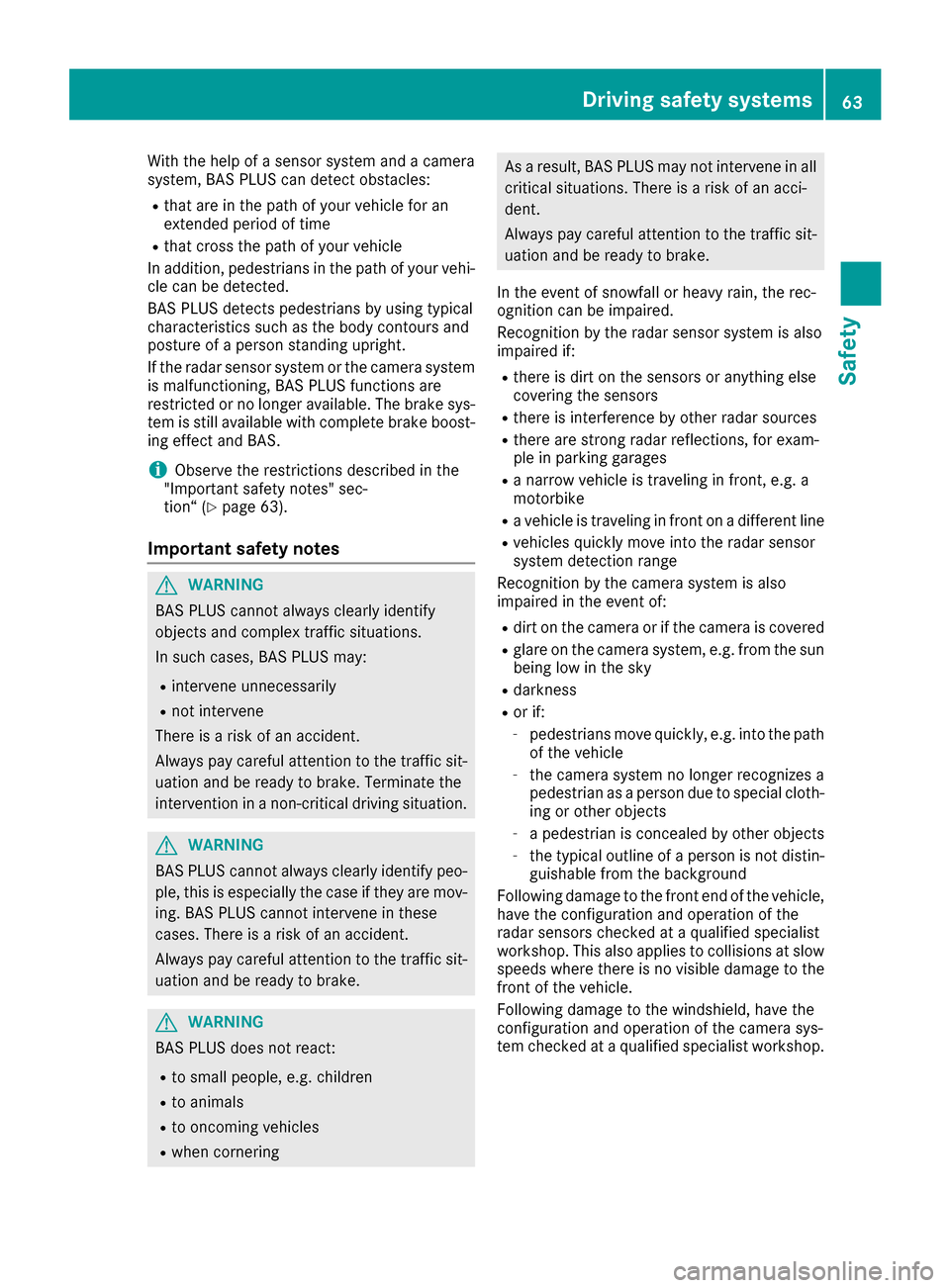
With the help ofasensor system and acamera
system, BAS PLUS can detect obstacles:
Rthat are in the path of your vehicle for an
extended period of time
Rthat cross the path of your vehicle
In addition, pedestrians in the path of your vehi-
cle can be detected.
BAS PLUS detect spedestrians by using typical
characteristic ssuch as the body contours and
posture of aperson standin gupright.
If the radar sensor system or the camera system is malfunctioning, BAS PLUS functions are
restricted or no longer available. The brake sys-
tem is still available with completeb rake boost-
ing effect and BAS.
iObserve the restriction sdescribed in the
"Important safety notes" sec-
tion“ (
Ypage 63).
Important safety notes
GWARNING
BAS PLUS cannot alwaysc learly identify
object sand complex traffic situations.
In such cases, BAS PLUS may:
Rintervene unnecessarily
Rnot intervene
There is arisk of an accident.
Always pay careful attention to the traffic sit- uation and be ready to brake. Terminat ethe
intervention in anon-critical driving situation.
GWARNING
BAS PLUS cannot alwaysc learly identifypeo-
ple, this is especially the case if they are mov-
ing. BAS PLUS cannot intervene in these
cases. There is arisk of an accident.
Always pay careful attention to the traffic sit-
uation and be ready to brake.
GWARNING
BAS PLUS does not react:
Rto small people, e.g. children
Rto animals
Rto oncoming vehicles
Rwhen cornering
As aresult, BAS PLUS may not intervene in all
critical situations. There is arisk of an acci-
dent.
Always pay careful attention to the traffic sit-
uation and be ready to brake.
In the event of snowfall or heavy rain, the rec-
ognition can be impaired.
Recognition by the radar sensor system is also
impaired if:
Rthere is dirt on the sensor soranything else
coveringt he sensors
Rthere is interference by other radar sources
Rthere are stron gradar reflections, for exam-
ple in parking garages
Ran arrow vehicle is travelin ginfront, e.g. a
motorbike
Rav ehicle is travelin ginfrontonad ifferentline
Rvehicles quickly move into the radar sensor
system detection range
Recognition by the camera system is also
impaired in the event of:
Rdirt on the camera or if the camera is covered
Rglare on the camera system, e.g. from the sun being low in the sky
Rdarkness
Ror if:
-pedestrians move quickly, e.g. into the path
of the vehicle
-the camera system no longer recognizes a
pedestrian as aperson due to special cloth-
ing or other objects
-ap edestrian is concealed by other objects
-the typical outline of aperson is not distin-
guishable from the background
Following damage to the fronte nd of the vehicle,
have the configuration and operation of the
radar sensor schecked at aqualified specialist
workshop. This also applies to collisions at slow
speeds where there is no visible damage to the
frontoft he vehicle.
Following damage to the windshield, have the
configuration and operation of the camera sys-
tem checked at aqualified specialist workshop.
Driving safety systems63
Safety
Z